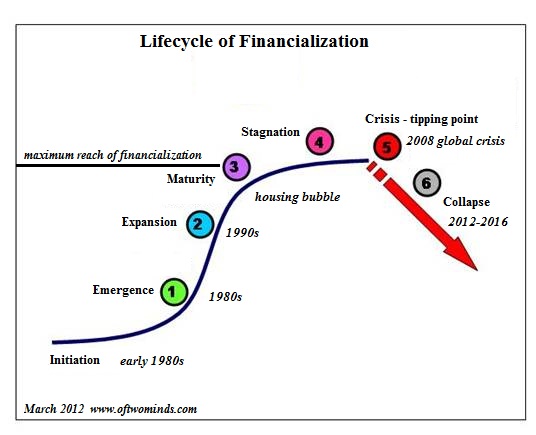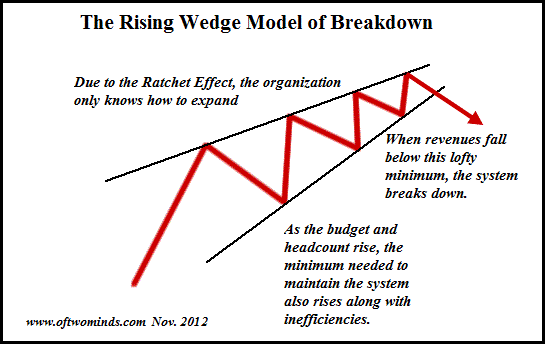When Escape from a Previously Successful Model Is Impossible
Three visualizations describe the breakdown of PSMs--previously successful models: S-Curves, Supernovas and Rising Wedges.
Microsoft has three product lines that underpin everything, Windows, Windows Server, and Windows Mobile. On those, the other moneymakers, Office and Exchange, run exclusively. The apps use protocols that are locked down with dubious methods, and will not run on any competition. The competition is likewise excluded from doing what Microsoft can, either directly like Novell, or by raising the cost to the point of it not being profitable. This is how the wagons are circled, with every iteration, the cost of competing go up, and value of alternatives go up too.
The problem is that if you are locked in with a choice of 100% Microsoft or 0% Microsoft, once someone goes, it isn't a baby step, they are gone. Once you start using Google Docs and the related suites, you have no need for Office. That means you, or likely your company, saves several hundred dollars a head. No need for Office means no need for Exchange. No need for Exchange means no need for Windows Server. No need for Office means no need for Windows. Once the snowball starts rolling, it picks up speed a frightening pace. And that is where we are. The barriers to exit are now even more potent barriers to entry.
Microsoft bought Nokia to both kill off one competitor and to buy their market share. Microsoft at the time had approximately 12% smartphone OS marketshare, Nokia a bit over 30%. With the collaboration, Nokia and Microsoft, together with all the other OS partners selling Windows Phone 7.x, sales are now hovering around 2% of smartphone market share.
Microsoft's mobile aspirations have failed so spectacularly that it is almost impossible to account for. Rather than fix the lock in that excludes the overwhelming majority of the market that does not have a Windows phone, Microsoft doubled down with the new iteration playing the same compatibility games they did before to lock out developers, competitors, and innovators.
The death spiral for Microsoft is in full effect, and management is expending a lot of effort to speed it up. Microsoft is unwilling to change, and that is very clear. Even if they wanted to, they are culturally far beyond the point of being able to. What was a slow bleed of marketshare is now gushing, and management is clueless, intransigent, and myopic. Game over, the thrashing will continue for a bit, but it won't change the outcome. Microsoft has failed.



My new book Why Things Are Falling Apart and What We Can Do About It is now available in print and Kindle editions--10% to 20% discounts.
 1. Debt and financialization
1. Debt and financialization2. Crony capitalism and the elimination of accountability
3. Diminishing returns
4. Centralization
5. Technological, financial and demographic changes in our economyComplex systems weakened by diminishing returns collapse under their own weight and are replaced by systems that are simpler, faster and affordable. If we cling to the old ways, our system will disintegrate. If we want sustainable prosperity rather than collapse, we must embrace a new model that is Decentralized, Adaptive, Transparent and Accountable (DATA).
We are not powerless. Not accepting responsibility and being powerless are two sides of the same coin: once we accept responsibility, we become powerful.
10% discount on the Kindle edition: $8.95(retail $9.95) print edition: $24 on Amazon.com
To receive a 20% discount on the print edition: $19.20 (retail $24), follow the link, open a Createspace account and enter discount code SJRGPLAB. (This is the only way I can offer a discount.)
| Thank you, James C. ($10), for your much-appreciated generous contribution to this site--I am greatly honored by your support and readership. |



























